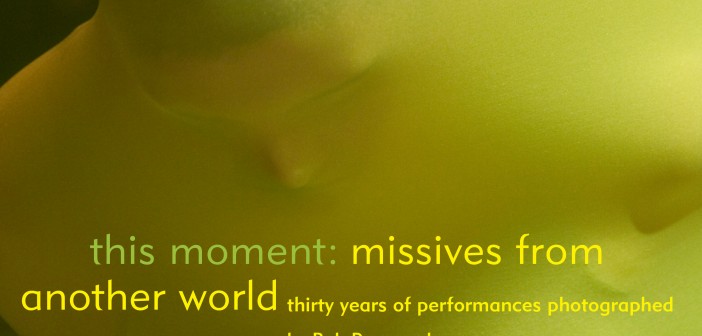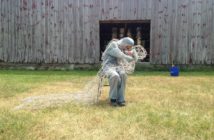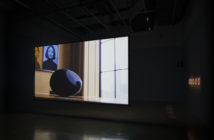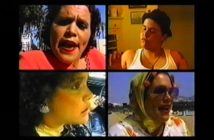A collection of performance art photography spanning decades, the book 'this moment: missives from another world’ provides a unique insight into the history of performance art in Boston, Massachusetts and beyond through the perceptive lens of artist Bob Raymond. Performance art is a set of potentials; there is no standard for how a work or a performance manifests. The medium permits the space for the artist to examine, question, and push limits. As a result, performance unfolds in real time which often means the work can take unexpected directions, making documentation an interminable challenge. Raymond’s photographic works raise questions about what can be left as a trace at the end of a performance while still paying respect to the ephemeral nature of the medium, and seeks to address how to capture immanence through documentation. Ultimately, the questions are raised: what remains after a work ends, or after the artist is gone? How much about the intent and context of the performance are we able to understand from the photographs alone? The works of Raymond may allow a viewer to move back through time to a specific moment, then to the present again. The images are time capsules, containing fragmentary glimpses into a vast range of performance works.
Mobius, a collaborative of artists, founded in 1975 by Marilyn Arsem, has operated as a venue in the Boston area and fostered the development of performance and experimental art by domestic and international artists. The group has supported artists' work that deals with questions, concepts, mediums, or materials that might omit them from showing in a traditional art gallery. The dedication to showing work from such a wide range of artists has resulted in the presence of Mobius on an international scale. In these last 30 years, the space has hosted thousands of performance events and has kept Boston on the map as a city with a strong performance art community. Raymond was an active member of the group and sought to archive the consistent stream of work being presented there most nights of the week from 1984-2011. The documentation he created were records that preserved brief moments of the ideas that were manifesting across mediums. By capturing the creation of these ephemeral works of art, Raymond left an archive of the work that was being made in Boston. The archive can be considered a record that addresses the history of performance art in Boston and expands its audience through Raymond's substantial documentation.
Performance art's ephemerality makes recording the work a relentless challenge for the artist, not to mention for audience members interested in capturing a moment of their experience with a work. Is it possible to be able to use a single image to articulate what happened in a performance and to also convey the feeling of the actions that took place over time? When Mobius was founded in the late 70’s, there were numerous performances that occurred without photographic or video documentation. Some artists would write about the work, explaining the context for the performance, their thoughts on it, or using audience responses and their own discoveries of what happened afterward. Some artists chose not to write. Because performance art is a medium that works against the idea of preservation, it can be assumed that the artists were not concerned about the lack of documentation early on. However, in later years when artists went to apply for grants or submit their work for festivals it had become standard for the artists to present a portfolio of documentation of past works. Many performance artists were omitted from these opportunities because they did not have records to show that they had in fact been making work.

JV= Jeff Huckleberry and Vela Phelan, Coffin 42, Quai #1 MEME Gallery Boston/ Quebec Exchange Project in Performance Art, 2010.
Photo Credit: Bob Raymond
What is specific about photography as a documentary medium is that it captures a brief moment of a larger whole. The moment is a glimpse into something that we might not have, or ever have the access to because we were not present at the live event. When I looked through the book, I experienced regret for not being able to be present for the live works that happened in Boston for the years that I was living here. I felt that there was so much the photographs in the book were trying to articulate about the experience of ‘being there’, and if I had been there that I might understand the choice of the images and why I feel specific ways towards some versus others. Raymond was positioning the viewer of these photographs to experience something, and my feeling is that the something is related to the feeling of experiencing the work live. He was attempting to preserve something of the live experience and have it expand through time, accessible through the glimpse his work provided back to that moment. A viewer cannot look at the photography of Raymond and expect a full understanding of what took place in the performances. What a viewer can get out of these photographs, however, is a sense of what happened; the images are akin to a story that is missing pages from the beginning, middle, and end. They are a proposal to stop and consider: what can be gathered from the information that is actually there within this frame? What does the image allow you to think about? What has been evoked?
“He had a rare ability to be with, and at times even withstand difficult art, with respect and patience.” (Speare 7) As one can imagine, it is difficult to come to a performance and to attempt to view it objectively. When we view art, regardless of the form, often our own thoughts can affect our experience and determine the level of engagement we might be able to have with a particular work. For Raymond to come to the performances day after day, week after week, for years and to attempt to always remain objective while documenting the work is not a small task. The works could range from minimal to maximalist, calm to explosive, buoyant or dismal. An evening of programming would often include multiple performances so the ability to move from one work to the next with equivalent attention being given to each artist was essential. These considerations were significant to the way that Raymond decided to document the work.
Before events would open to the public, Raymond would go to Mobius to discuss documentation with the artists. Before they set up for their performances, he would ask what format of documentation they desired and where they would be in the space so he could best figure out how to make the record for them. This would allow for some time to consider if the artist wanted to have documentation taken from an angle that was visibly part of the image, or if the artist wanted the camera to be held by Raymond whom would sit among the audience to make his presence as a documenter less pronounced. There are some performance works that for various reasons are intentionally not recorded or documented in the time of the live work as it unfolded in space. Some of these reasons may have included the contradiction of using documentation when considered with the concept of the work. He was not only sympathetic to the artists who requested the work not have a record but was understanding of the reasons why. Raymond understood that the artists vision for the live performance work was important, and did not want to jeopardize the concept. When he was asked to not record, he put his camera away and watched.
Another scenario was when artists declined documentation of the live work, but still requested assistance in realizing a document after the performance. This desire could have happened for a variety of reasons, like wanting more control over the image to be documented, which could be possible only without the variable of the audience, for example. It was said that Raymond went out of his way to be as quiet as possible with his camera, with the concern that the presence of the camera within the performance would affect the work by diverting attention from the artists. He went so far as to try out most cameras on the market until he finally came across one that was silent enough to be his camera of choice. What came first and foremost for Raymond was a deep respect for the work that was being presented, no matter the content, and allowing the artists to see their vision through.
Within the final years of Bob’s life, there was a transition in his approach to documentation. The progression happened slowly, as he fostered a considered approach that would suit the documentation needs of the artists and at the same time satisfy his drive to produce records that are works of art as well. During this progression, he began photographing and filming the performances with a more prominent incorporation of his aesthetic. What this meant was that instead of documenting the work in a traditional way, he wanted to challenge the convention of performance photography. Instead of working with the standard impersonal distance shots, he strove to capture the shots that would depict intimate instances within the work. He captured the moments of climax, he caught the moments of silence. He sought to find solutions, with the artists permission, to make an image possible for works that were elusive or meant to elude documentation. He had found a way to incorporate the ephemeral within the lasting medium of photography; he gave permanence to a feeling evoked when viewing a photograph of a cursory time.
He would work on the editing and printing of select performance images in his free time, painstakingly removing dust from negatives so that the images would be as clean as possible. One day at Mobius, Bob brought in select images from his collection of documentation from over the years to share with the artists. “Recalling the day Bob first displayed these images to the Mobius Artist Group is a moment irreducibly etched in Mobius lore.” (Speare 8). The book contains a select 70 images from approximately 35,000 images that exist within the archive, curated by Raymond himself originally for an exhibition at Studio Soto.
To consider documentation the way that Raymond did required extreme sensitivity to the desires of the artist, regarding their needs for documentation while maintaining an awareness of what was happening and unfolding in front of him in real time, as well as the ability to adapt to the changes that are presented to the performer and audience during the creation of a live work. In short, an open mind with acceptance for the medium of live work as a whole was required for this vision to be realized. In regards to his views on documenting work, Raymond explained:
“Looking through the photographic archives of Mobius, Inc. I am sometimes struck by the thought: “Why is s/he doing that?” It’s not that I don’t know, but it’s almost as if, divorcing myself from the specific knowledge, if I had not been there, if I had not seen this before, looking at this still image I would ask that question: “What are they doing and why are they doing it?” I do not believe this is a particularly new thought to anyone familiar with performance art in general. I believe most knowledgeable observers view the work with the belief that the performers are compelled to perform these actions, present these images; they are compelled to douse themselves with all manner of liquids, create (often) disturbing images, repeat a set of actions to exhaustion, test themselves and their audiences in myriad ways.” (Raymond 24)
In later years, Raymond began to pursue collaborations with performance artists to make performances for the camera. He worked with Marilyn Arsem to create performances for the camera during the If To Drift Residency Project in Bristol, Maine titled ‘Embedded’ (South Bristol, Maine. August 18, 2009. Digital). In the selected image, Arsem is hanging the upper half of her body over the edge of a small mound in the woods. The wall of the hill is exposed from the fallen dirt, in which roots of a large tree and smaller plants are visible. Her hair is coming undone and the loose strands follow the linework of the exposed roots. The image is evocative of the proximity in which death hovers, and the imminence of life itself. In another work, Raymond collaborates with artists Sara June to capture a performance for the camera in Limbic Formation (performance for the camera with PLEO robot, Zero Plan, Boston, MA 2010). The image depicts June reclined on a futon with a toy dinosaur balanced on her torso. The image immediately surfaces associations with psychiatrist offices and the position that a client can take within the space to recall topics of concern for the timed session. The dinosaur feels like a representation of something carried from adolescence without a clear indication of what that could be or why. It reads like a lucid dream. The interest in this method of working with others was to create a desired outcome from both parties. This was not completely unlike his experience of figuring out ways to document work that was too challenging to record during the live performance and the application of alternative methods to making a documentation of work after the fact.
The questions around documentation are questions that are parallel to what we ask about life itself. Where did it begin, where does it end, what will become of these documents? The reality is that the documents will eventually disappear just like the human body will eventually; it is a haunting but very aware way of considering this work. Raymond made a huge effort to record and preserve the work of Boston performance artists. The archive he made was one that will last, and will show people that important art was and still is being made in Boston.
The book is a limited edition print available in select locations in the United States, Canada and online through Mobius. Store locations include: Museum of Fine Arts Boston, Institute of Contemporary Art, Papercuts J.P., Boston Cyberarts Inc., and Formats.
Bibliography and Further Reading
Jones, Amelia, and Adrian Heathfield. Perform, Repeat, Record: Live Art in History. Bristol: Intellect, 2012. Print.
McMurry, Jamie. “The Role of Documentation in Time-Based Art’. Master of Fine Arts Thesis in New Media, Donau-Universitat Krems
Raymond, Bob. This Moment: Missives from Another World; Thirty Years of Performances Photographed by Bob Raymond. Cambridge, MA: Mobius, 2015. Print.
Speare, Jed. "Preface: The Dedication of Bob Raymond." This Moment: Missives From Another Worlds: Thirty Years of Performances Photographed by Bob Raymond. Bob Raymond. Cambridge, MA: Mobius, 2015. Print.
Vason, Manuel, and Dominic Johnson. Encounters, Manuel Vason: Performance Photography Collaboration. Bristol: Arnolfini, 2007. Print. Rebecca Schneider piece
Vason, Manuel. Double Exposures: Performance as Photography, Photography as Performance.




